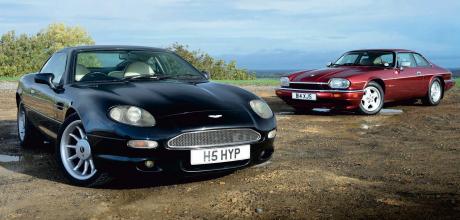Aston Martin DB7 vs. Jaguar XJS
Despite coming from two different manufacturers, by sharing much below the surface, the DB7 and Jaguar XJS are closely related. We compare a straight six-engined example of each to discover which of these surprising siblings we prefer.
WORDS AND PHOTOGRAPHY: PAUL WALTON
It’s surprising how many of us have unexpected relatives. Former American presidents Barack Obama and George W Bush, for example, are apparently tenth cousins while the comedian, Josh Widdicombe, is a descendant of the 14th century British monarch, King Edward I. Even more amazingly, my wife is said to be related to Sir Isaac Newton.
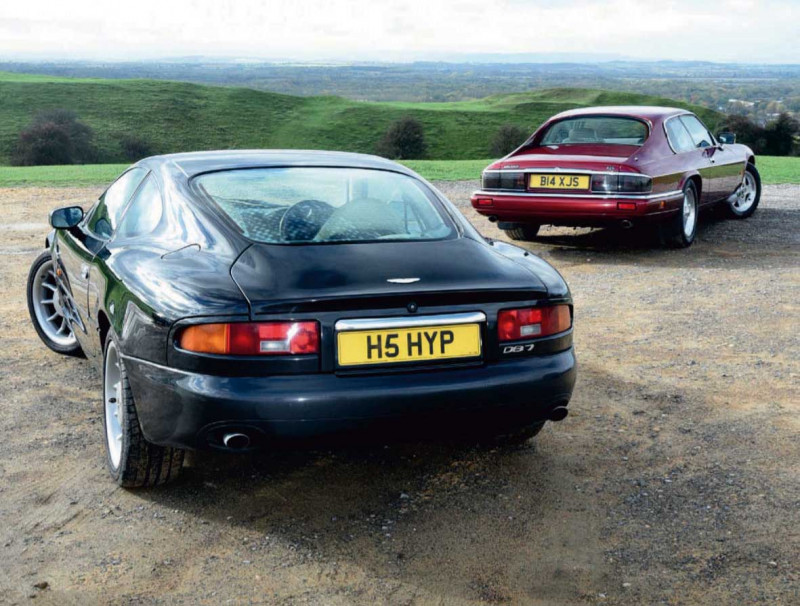
Yet perhaps the most unexpected family members are the Aston Martin DB7 and Jaguar XJS. Despite being as different in character and image as my wife is from a 17th century astronomer, physicist, and mathematician, with one heavily based on the other, they aren’t so much distant relatives as non-identical twins.
When I open the driver’s door of this 1997 example, it’s difficult to understand how Aston dared to charge so much
But like all siblings, with their production overlapping by a couple of years, it made the pair rivals. So, like choosing between two very different but unexpectedly related American politicians, which of these automotive siblings do we prefer today?
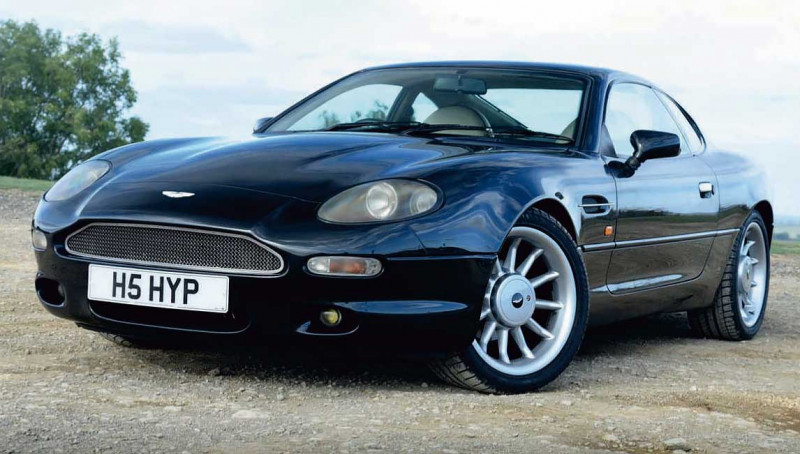
The reason for this association is simple; the DB7 started life in the late Seventies as a Jaguar, an XJ40-based sports car project that would have eventually replaced the XJS. Internally known as the XJ41, it was the work of Jaguar designer, Keith Helfet, who was (and still is) unashamedly influenced by the company’s most iconic model, the E-type, meaning it had a very classic look compared to the many wedge-shaped models of the era such as the BMW M1 E26, Ferrari 308 GT4 and the Lotus Esprit. “For me, the origami styling fashion from the mid-Seventies was completely unappealing,” he said during a 2018 interview about the car. “I don’t do square lines; I do flowing sculpture and that’s what Jaguars are about.”
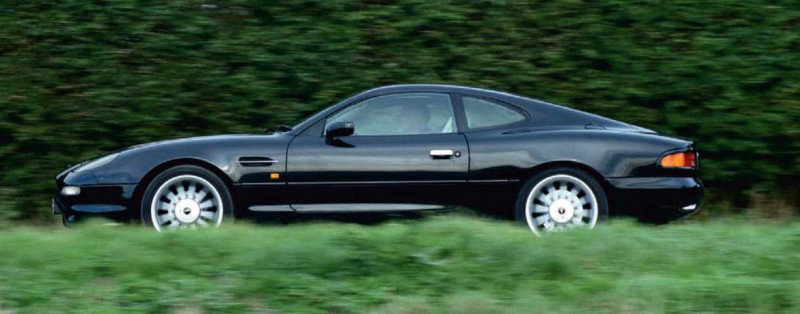
Despite ten years of constant development, due to its increasingly complicated specification which later included a turbocharged engine and all-wheel drive, the XJ41 was canned in 1989 by Jaguar’s then new owner, Ford, due to rising development costs.
Keith was naturally devastated by the decision. “I was distraught, I was absolutely gutted. It had all gone so sour and I was really upset about it,” he continued.
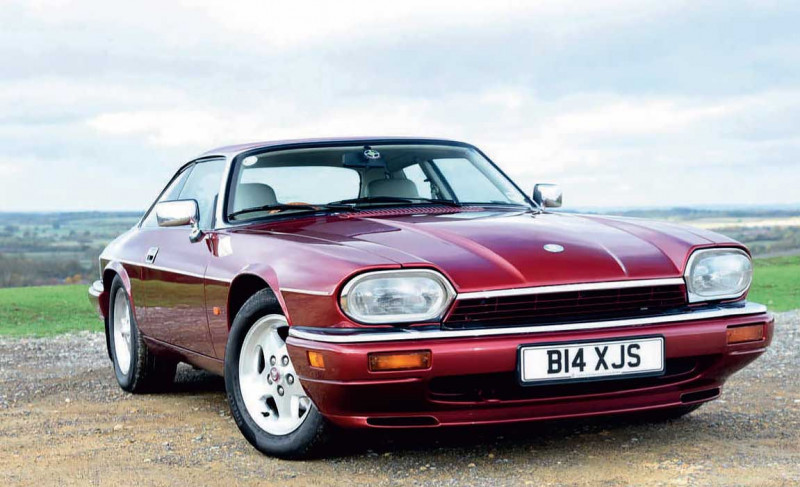
Not a man to give up, he later realised the hard points of both the XJ41 and XJS were the same, meaning the body of the new car would fit onto the chassis of the older one, so his design could be resurrected at a fraction of the original cost. Jaguar’s engineering director, Jim Randle, brought up the proposed project at the next board meeting of JaguarSport (a satellite company owned 50/50 between Jaguar and Tom Walkinshaw Racing). The independent motorsport team that had taken Jaguar back to the winner’s circle of the Le Mans 24 Hours, was also in the process of building the company’s XJ220 supercar. Walkinshaw himself saw the potential of the XJS-based XJ41 and agreed to take the reborn car on when it became known as Project XX.
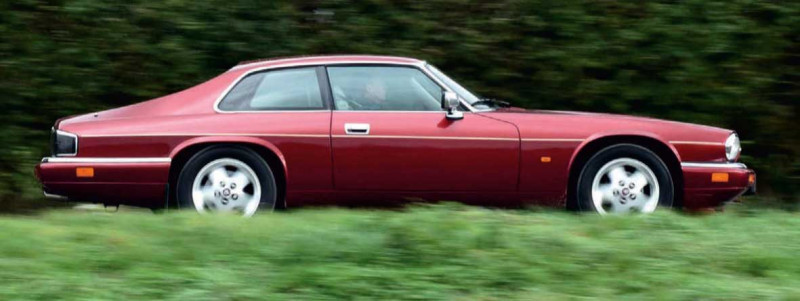
Unbeknown to Keith, Jim and everyone else at Jaguar, Walkinshaw later approached Ford’s senior executives suggesting if the car was badged as an Aston Martin – which the American company had also bought in 1987 – it could be sold for a much higher price. The American giant readily agreed to the plan, securing the car’s future pedigree. When Jaguar heard about this, though, it quickly became known as ‘Project Double Cross’. Although the car would be assembled at the former JaguarSport facility located outside Bloxham where the XJ220 had been produced, Aston soon rechristened it NPX, which stood for Newport Pagnell Experimental.
The design remained largely as per the XJ41 although TWR’s chief designer, Ian Callum, added the familiar Aston Martin radiator grille. “I did a complete review of the DB7’s predecessors to determine the styling cues that make an Aston an Aston,” said Callum in the June 1993 issue of Automobile magazine. “To get the ‘atmosphere’ right, I focused on the DB4, the DB5 and DB6. They are the most successful Astons, visually, and the ones people remember most. I wanted to design something that has its own personality but evokes their honesty and integrity without being a pastiche.”
Despite the change of pedigree, the chassis and suspension (double wishbones at the front with lower wishbones and driveshafts acting as upper links at the back) remained largely as per the XJS. Even the engine was Jaguar-sourced, a 3.2-litre version of the company’s by now elderly AJ6 straight-six unit that first saw the light of day as a 3.6 in 1983. Not only did this keep development costs down but it fulfilled the desire of Aston’s then chairman, Walter Hayes, for a six-cylinder since it was the same as those used by the company’s iconic past models.
To create lots of usable torque from a high-revving, short stroke engine but minus the lag associated with turbos, it was fitted with a supercharger sourced from an American automotive engineering specialist, Eaton. This raised the power to 335bhp resulting in a 157mph top speed and a 0-60mph time of 5.8 seconds, putting the car’s performance on a par with the BMW 850 CSi E31, Mercedes-Benz SL500 R129 and the Porsche 911 993.
The engine and chassis weren’t the only components that were recycled since much of the car was also sourced from companies both within and outside of Ford’s empire. The rear light clusters and chromed door handles, for example, are both from the Mazda 323 while the wing mirrors came from the Citroen CX. The electrical and ventilation systems came from Jaguar.
Yet Walkinshaw remained unrepentant about this heavy parts sharing. “There was never any talk of designing a car that was brand new from the ground up,” continued the Scot in Automobile magazine. “It was essential to use components available in the Ford family.”
None of that mattered, though, when the finished model made its debut at the 1993 Geneva Motor Show and the critics were swayed by its handsome looks. “Subjective an issue as taste maybe, the new Aston’s aesthetics are inescapable” said Motorsport magazine when it finally experienced a car for its December 1994 issue. “Its proportions are exquisite, its purpose unmistakable.”
The eventual name also did much to hide the car’s outsourced origins; by christening it the DB7, it instantly linked the new model to its iconic predecessors. The company’s former owner, David Brown, was apparently very happy by the decision. “I am of course delighted and very honoured that the new Aston Martin should be designated a ‘DB,’” he wrote in a 1993 letter to Walter Hayes. “From what I have seen of it, I am sure it will be a world beater and more than worthily uphold the ‘DB’ tradition.”
Yet it wasn’t cheap. At £78,500, when the DB7 went on sale a year after its Geneva debut, it was £40k more expensive than the XJS 4.0 and five grand over the cost of the Porsche 928 GTS. But importantly, it was almost £100k less than the existing and still largely handmade Vantage, positioning Aston Martin in a new, more mainstream market for the first time.
When I open the driver’s door of this 1997 example, it’s difficult to understand how Aston dared to charge so much. The switchgear is clearly sourced from Ford resulting in the same plasticky atmosphere as a Scorpio, while the thin and cheap-looking veneer isn’t an integral part of the dash like it is in the XJS but simply stuck onto the central console with holes for the ventilation controls. Plus, admittedly this example has done 97k miles, but it hasn’t worn well with much of the leather fraying in places or even coming apart due to poor stitching. Despite the healthy 335bhp from the engine, because of the slow and lazy nature of the four-speed automatic fitted to this example, I have to give the throttle a proper shove for it to kick down and generate any kind of purposeful response from the engine. Admittedly, the resultant acceleration feels strong, more so than the XJS’s 4.0, but due to the rough and raucous noise coming from the engine, pushing the DB7 hard is never a pleasurable experience. This lack of refinement might have been acceptable in the Eighties when the engine was new, but by the following decade it must have made the car feel incredibly old-fashioned, especially for one that cost close to £80k.
Where the DB7 comes into its own is the handling. With taut, well-damped suspension, it remains composed at all times which with the perfectly weighted steering results in a car that feels like a genuine sports car. The downside is a firmer ride than its Jaguar sibling, picking up imperfections in the road that the XJS would have glided over.
Yet for all its faults, the DB7 is still a hugely likeable car with massive amounts of character. Plus it has rarity on its side, too; just 2,473 3.2s were produced compared to 21,702 XJS 4.0s, although this does have an impact on their values. A DB7 3.2 coupe, similar to the example featured, is worth between £20k-£25k, a good ten to fifteen grand over an XJS 4.0. But just as when the car was new, is it worth the extra money over its Jaguar relation?
With Aston Martin taking over Project XX, Jaguar no longer had a replacement for the XJS which by 1990 was 15 years old. Other than a minor facelift in the early Eighties, that had seen the introduction of a slightly more economical version of the thirsty 5.3-litre V12 – the HE – plus the 3.6-litre straight-six (AJ6) and a more traditional interior where wood replaced the harsh black vinyl of the original, the car remained almost as when it first went on sale in the mid-Seventies.
While Jaguar’s engineers developed a largely brand-new model, the eventual XK8 from 1996, the short-term solution was to give the XJS a major £50m facelift. Although the car’s overall design didn’t change, it resulted in several detailed updates which included a flatter roofline, the deletion of the front quarter lights and window surrounds plus new rectangular smoked rear lights. The bodywork also benefitted from a new manufacturing process at Jaguar’s Castle Bromwich plant. Of the 490 panels it took to build an XJS bodyshell, 180 were changed to improve build quality. For example, the original wings were made up of five different pressings all individually welded together, but in the new car they were manufactured in a single pressing. Inside, the unusual ‘tumbler’ style of dials of the original were replaced with traditional circular gauges taken from the XJ40 saloon, plus there was updated switchgear.
Together with new lattice-style wheels, updated exterior colours and interior trim plus a 4.0-litre version of the AJ6 that now produced 223bhp, it brought the XJS into the new decade. “The changes have made it look smarter from most angles,” was the view of Autocar magazine in 1991.
The XJS was given another minor update in 1993, which saw new colour-coded plastic bumpers that arguably made it more contemporary. But more importantly, there was also a new version of the 4.0, the AJ16 from June 1994, that had a new cylinder head and block, revised cam profiles, a higher compression ratio with new pistons, lightweight valve gear plus new sequential fuel injection, all designed to improve the engine’s performance and durability. With another 18bhp over the 4.0-litre AJ6, the car’s 0-60mph time dropped to 6.9 seconds while economy improved by 5.9 percent to 24.3mpg.
Despite the car being by now close to two decades old and in terms of its design and interior packaging clearly old-fashioned compared to newer models, these changes helped it to remain relatively popular and in 1994 6,918 examples of all varieties were produced. Admittedly at under £40k the car was more affordable compared to some of its rivals, the DB7 especially, but judging by this handsome Flamenco Red 4.0-litre example, cheap or not, it’s still easy to understand that number.
With its big, bold proportions, the XJS was always a good-looking car, but the new plastic bumpers and modern style of alloys made it more so. Although I’d argue the DB7 is prettier, there’s no denying the XJS has real presence, aided in no small part by those unique and always controversial buttresses located behind the rear screen.
Admittedly this pristine XJS has a mere 25,000 miles on the clock, but the Jaguar’s interior is better built than the DB7’s. Not only is the quality of the plastics better and the veneer thicker, but there’s less obvious reliance on Ford parts. And although clearly old-fashioned, it makes no apologies for that and unlike the Aston isn’t trying to be anything else.
It always amazes me how little room the XJS’s cabin offers for such a large car. Not only are the rear seats unusable but even the front can feel tight, more so than the DB7 due to the shape of the glass area.
With the XJS’s straight-six producing 241bhp, 94 less than the DB7’s supercharged 3.2, acceleration can best be described as sedate, reaching 60mph in a fairly lethargic eight seconds. Pressing the sport button on the gearlever surround helps a little, allowing the engine to rev harder until the four-speed ZF-sourced automatic gearbox changes up.
Yet it never feels as sprightly as the DB7, the normally aspirated unit never as eager to deliver its power as the supercharged version. It’s more refined, though, and squeezing the throttle hard doesn’t result in the same deafening roar as the DB7’s 3.2.
Where the XJS really comes into its own is the suspension. Supple enough to absorb the worst that the poor state of our roads has to offer yet still having a firmness to control body roll enabling me to take corners reasonably quickly. Although at 1,612kg it’s 138kg lighter than the DB7, it doesn’t feel as agile, which together with the overly assisted steering means it’s never a true sports car like the Aston gets close to being. Despite the many updates and changes of engine the XJS had over the years, the car still ended as it started, as an old-fashioned grand tourer.
It’s clear by this example that even at the end of its production the XJS remained a highly desirable and soughtafter car. But is it special enough to take on the rarer, prettier, and more performance-focused DB7?
I make no apologies that I openly admit to loving both of these models. The XJS is a car I have admired since I was a child and have considered buying one several times. Plus the DB7 featured here is AMD’s own project car and during the many hours spent behind the wheel I’ve come to fully appreciate how special the model is. An exciting, late night drive thundering down the A1 following the photoshoot in Yorkshire with the V12 GT featured in issue six will remain with me forever.
Yet in my view there’s one clear winner out of the two – the XJS. As engaging as the Aston Martin can be to drive, in terms of refinement and build quality, it can’t compete with the Jaguar. The DB7 might be prettier, but its poor build quality and dated engineering counteracts those good looks. The XJS clearly isn’t be perfect but it’s less of a compromise than its parts bin special Bloxham sibling.
Plus, I can’t ignore their current values. Although 25k is cheap for an Aston Martin, especially compared to the six-figure sums of its famous DB predecessors, by coming from the same lineage as the iconic E-type, ten grand makes the XJS 4.0 arguably more so. So as closely connected as the two cars are, as my wife’s relationship to Newton shows, being related doesn’t always result in being similar.
Thanks to: Owner of the XJS 4.0 featured here, Ian Collier


